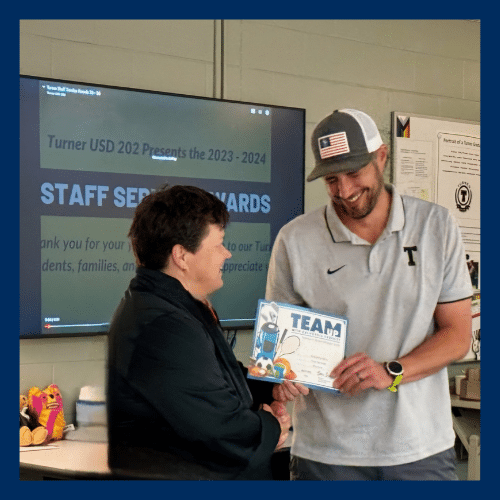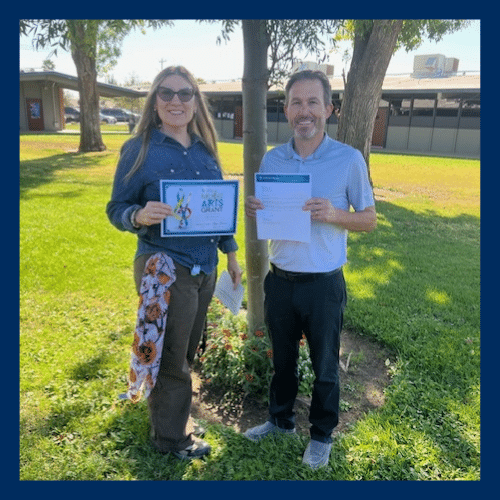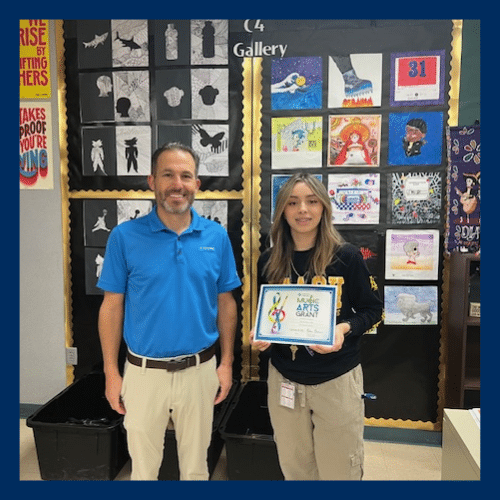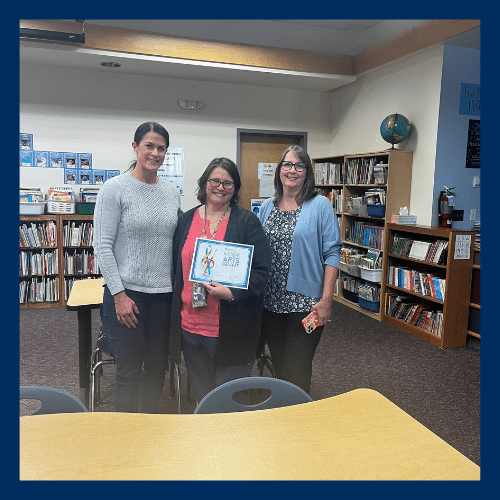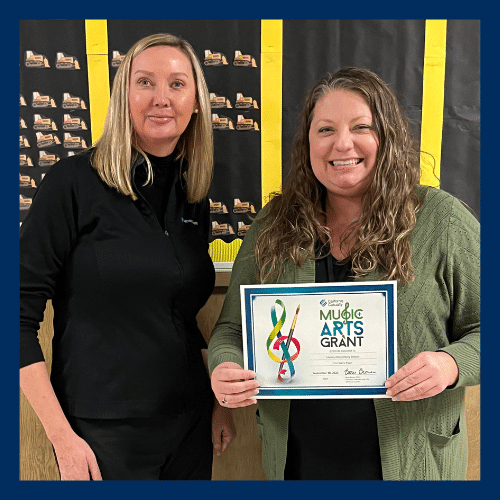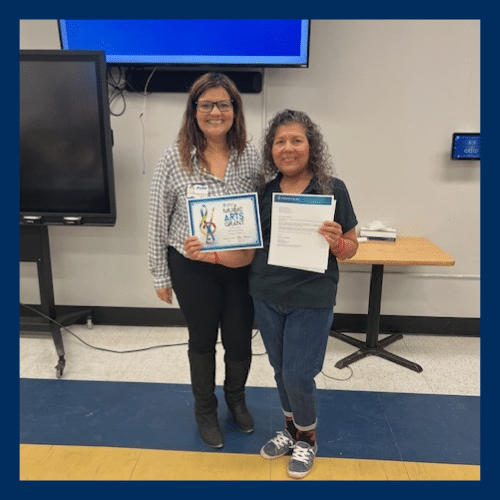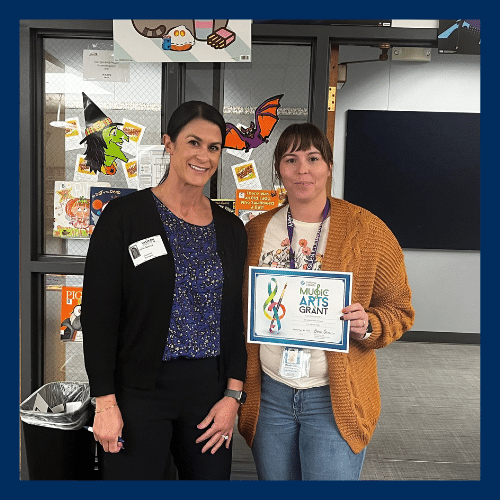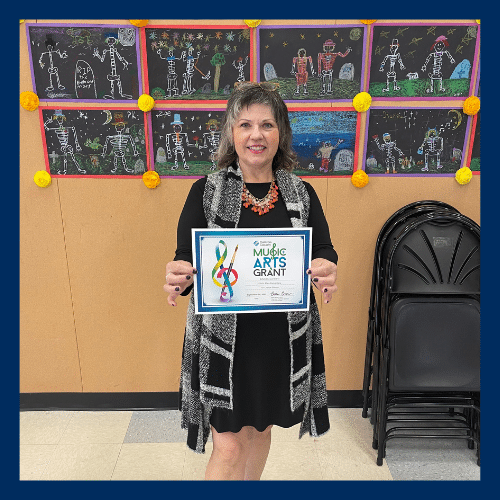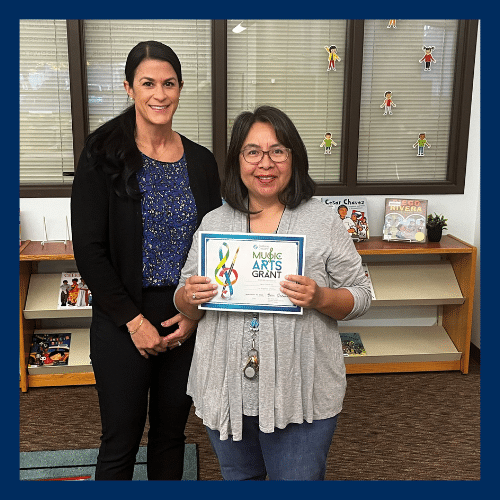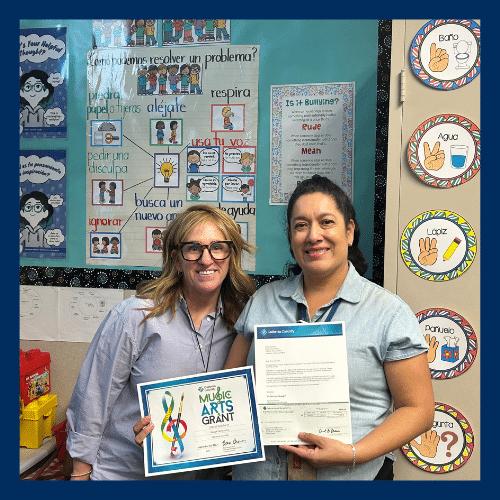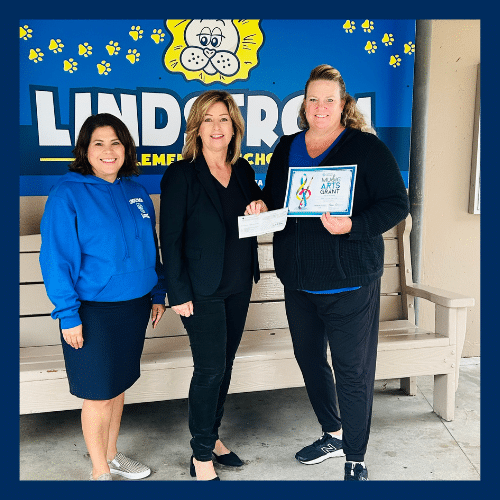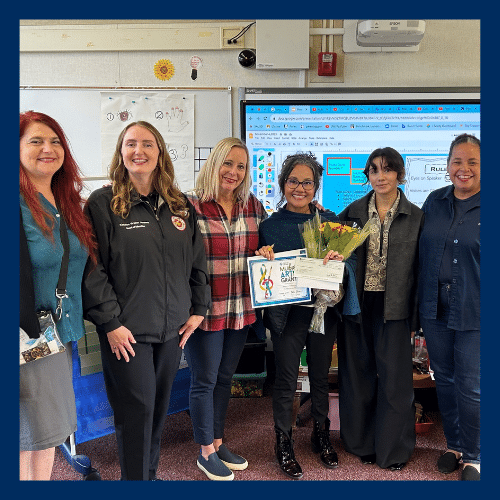
by California Casualty | Educators, Press Releases |
California Casualty has delivered $1,000 Thomas R. Brown Athletic Grants to educators at 13 public middle and high schools across seven states to help support their school sports program(s). Since its inception in 2010, the Thomas R. Brown Athletics Grant Program has helped fund burdened athletic programs in 763 public schools across the nation.
Named in honor of Tom Brown, an ardent sports enthusiast and California Casualty Chairman Emeritus, the Thomas R. Brown Athletic Grant reflects his conviction that the values cultivated on the field—such as teamwork, trust, communication, and confidence—extend far beyond sports, enriching academic and personal development. Athletic programs play a pivotal role in shaping students’ character, fostering well-rounded individuals who excel both in the classroom and in life.
“The athletic departments mission is to provide our students who come from an underserved community the opportunity to develop sport skills by maximizing participation and focusing on fundamental skills. El Camino Jr. High School sports focus on developing positive values, learning sportsmanship, teamwork, communication and cooperation. This grant will go towards purchasing equipment such as volleyballs, basketball, ball racks and nets…. to enhance the lives of our student athletes,” said CTA Member and applicant Ashley Sandoval.
California Casualty recognizes the vital role of youth sports in promoting children’s physical and mental well-being. We are delighted to announce that the 2023/2024 Athletic Grants will support the following initiatives:
-
- Angevine Middle School, Lafayette, CO – Basketball, Flag Football, Soccer and Track
- Burley High School, Burley, ID – Wrestling
- Challenger Middle School, Tucson, AZ – Boys and Girls Soccer
- CY Middle School, Casper, WY – Boys Soccer
- Del Campo High School, Fair Oaks, CA – Girls Flag Football
- Del Mar High School, San Jose, CA – Football
- El Camino Jr High, Santa Maria, CA – Basketball and Volleyball
- Hillsboro High School, Hillsboro, OR – Cheerleading
- Montebello High School, Montebello, CA – Girls Golf
- Scappoose High School, Scappoose, OR – Bowling
- Shadow Hills High School, Indio, CA – Boys and Girls Soccer
- Syringa Middle School, Caldwell, ID – Boys Basketball
- Turner High School, Kansas City, KS – Boys and Girls Golf
Congratulations to all of our 2023/2024 grant recipients!
Angevine Middle School, Lafayette, CO
Scappoose High School, Scappoose, OR
Hillsboro High School, Hillsboro, OR – Cheerleading
Shadow Hills High School, Indio, CA
Del Mar High School, San Jose, CA
Burley High School, Burley, ID
El Camino Jr High, Santa Maria, CA
Del Campo High School, Fair Oaks, CA
Montebello High School, Montebello, CA
Turner High School, Kansas City, KS

by California Casualty | Educators, Helpful Tips |
It’s time for a well-deserved break and a chance to catch up on your reading. Whether it’s for professional development or relaxation, a summer reading list is a staple for educators. Let’s explore some must-reads to make the most of your summer downtime.
Professional Development
Creatively Productive: Essential Skills for Tackling Time Wasters, Clearing the Clutter, and Succeeding in School—and Life!
(Lisa Johnson, 2019)
If you struggle with organization and efficiency in today’s information-laden, hi-tech world, imagine how your students must feel. This book seeks to provide the strategies that help you, and them, navigate the demands of school and life effectively. These are the skills and resources that can help prepare students for future success.
The Fun Teacher’s Tool Kit: Hundreds of Ways to Create a Positive Classroom Environment & Make Learning FUN
(Rob Plevin, 2017)
Adaptable to any subject area, this book offers activities, resources, and ideas to bring energy, engagement, and motivation to teaching and learning. The author provides strategies to build relationships with hard-to-reach students. The author is a trainer who runs “unforgettable” courses for educators.
Hacking Classroom Management: 10 Ideas to Help You Become the Type of Teacher They Make Movies About
(Mike Roberts, 2017)
As Utah English Teacher of the Year, author Mike Roberts has been successful in creating a learning environment that engages students. His tips help maximize teaching time, reduce behavior issues, and enhance student ownership. From year-long future planning to quick tips to implement tomorrow, he offers the principles and practices that make a difference in classroom management.
Teaching with AI: A Practical Guide to a New Era of Human Learning
(José Antonio Bowen and C. Edward Watson, 2024)
Artificial intelligence (AI) is changing how we work, think, create, and learn. It’s already in the classroom, and teachers must be able to navigate this new tool in largely uncharted waters. From interactive learning to assessments, this book offers a practical guide toward integrating AI in the classroom while retaining academic integrity.
The Ten-Minute In-service: 40 Quick Training Sessions that Build Teacher Effectiveness
(Annette Breaux and Todd Whitaker, 2021)
This quick read might just revolutionize your in-service training next year. It offers quick training sessions with practical strategies that offer high-impact results. Even the best teachers can find ways to improve. If you find this book helpful, share it with your principal.
Self Help
Atomic Habits: An Easy & Proven Way to Build Good Habits & Break Bad Ones
(James Clear, 2018)
There are tiny changes that you can make in your life that can have big and lasting results. That’s the idea behind Atomic Habits. Author James Clear uses biology, psychology, and neuroscience to help make good habits inevitable. Despite being time-crunched or having a lack of motivation, you can be successful with this innovative approach.
Powered by Me: From Burnout to Fully Charged at Work and in Life
(Newa Sangwan, MD, 2023)
As the author states, “Burnout isn’t a failure. It’s a wake-up call.” Dr. Sangwan explains the five levels of burnout—physical, mental, emotional, social, and spiritual—and how to address each one. She will help you align your decision making on what matters most to you, and as a result, connect to your colleagues and your job in a new way.
Take Time for You: Self-Care Action Plans for Educators (Using Maslow’s Hierarchy of Needs and Positive Psychology)
(Tina H. Boogren, 2018)
The author is a former teacher and instructional coach who understands the challenges to mindfulness that can be present for educators. She walks you through a process that helps you reflect on your life through Maslow’s hierarchy of needs, using positive psychology as a guide toward developing a personalized plan for self-care.
Fiction/Memoir
Being Henry: The Fonz…and Beyond
(Henry Winkler, 2023)
Henry Winkler is an Emmy award-winning actor, author, comedian, producer, and director. He achieved these successes despite severe dyslexia. His memoir offers a vulnerable look at the challenges he faced, including the pressures of his signature role that took a life of its own and what to do when it seems your best years are behind you.
Lessons in Chemistry
(Bonnie Garmus, 2022)
This global bestseller inspired a hit television series. It follows the journey of chemist Elizabeth Zott in the early 1960’s as she navigates a male-dominated society where women are supposed to be homemakers. When she finds herself a single mother, she has to improvise. As the host of America’s beloved cooking show, she turns chemistry into delicious results.
The Lost Bookshop
(Evie Woods, 2023)
This charming and uplifting novel is a fun read for those who love books. It follows the stories of three strangers who discover a vanishing bookstore in Dublin. In search of a long-lost manuscript, the characters find themselves transported to a world of wonder where nothing is as it seems.
Do you have a book suggestion that’s not on the list? Share it in the comments.
This article is furnished by California Casualty, providing auto and home insurance to educators, law enforcement officers, firefighters, and nurses. Get a quote at 1.866.704.8614 or www.calcas.com.

by California Casualty | Educators, Finances, Helpful Tips |
It’s a tradition in teaching to reach into your own pocket to cover classroom supplies and those fun ‘extras’ that make learning memorable. Educational grants can help. From pencils to white boards to field trips, these grants can offset your expenses and, in some cases, boost your school’s budget.
Unlike other types of funding, grants do not have to be repaid. Most grants require an application, and a report on how the money was spent. Some can be competitive. If you meet the criteria and the deadline, however, you’re on your way to earning free money.
We did a deep dive to discover some of the best and most innovative grants for educators, both on the national and state levels. Here’s what we found.
National
Colibri Special Project Grant
Up to $5,000
These grants fund projects that significantly advance student learning and create engaging student experiences. Grants are for grades K-12 in public schools. Please note however: these grants do not fund textbooks for schoolwide use, technology or A/V equipment, travel, admission fees, or field trips.
https://www.colibrigrants.org/
Dollar General Literacy Foundation
$4,000
Dollar General offers youth literacy grants to help students below grade level. The grants can be used to implement new or expand existing literacy programs, purchase new technology to support literacy initiatives, or to buy books, materials, or software.
https://www.dgliteracy.org/grant-programs/?#youth-literacy-grants
Kids in Need Foundation
Boxes of supplies
The Supply a Teacher program seeks to provide necessary resources for teachers in underserved schools. These grants are open to teachers at schools where 50% or more of students qualify for the National School Lunch Program. Applications are accepted year-round.
https://www.kinf.org/for-teachers/
NEA Foundation
$1,500 – $5,000
NEA Student Success Grants are meant to elevate and improve student development through project-based learning in public schools. Funds may be used for materials, equipment, transportation, or technology. To be eligible for this grant, you must be a member of the NEA.
https://www.neafoundation.org/educator-grants-and-fellowships/student-success-grants/
Pets in the Classroom
Award varies
Grants are available for PreK through 9th grade teachers to purchase and maintain small animals in the classroom. There is also a Dogs in the Classroom program that supports animal-assisted therapy.
https://petsintheclassroom.org/
Toshiba American Foundation Grants
Up to $1,000 (K-5) and $5,000+ (Grades 6-12)
These grants are for project-based learning in science, technology, engineering, and math. Note however that the Foundation does not fund computers, laptops, or tablets.
https://www.toshiba.com/taf/
Voya Unsung Heroes
$2,000 – $25,000
Voya funds innovative projects for K-12 classrooms, both public and private. Project areas span the curriculum, and include history, social sciences, psychology, economics, political science, career technical education, English, music, art, physical education, nutrition, and wellness.
https://www.voya.com/page/voya-unsung-heroesr
Arizona
Arizona School Boards Association
$500
Each quarter, the ASBA awards grants to enhance PreK-12 classroom learning. Teachers must describe how the project will impact student achievement and how it reflects the priorities of their district. Grant winners must attend a board meeting where they will be recognized.
https://azsba.org/awards/classroom-grants/
California
California Retired Teachers Association
$100
This organization provides funds for teachers to use in their classrooms however they like. There also are local CalRTA divisions that offer direct support for local schools.
https://calrta.org/teacher-grants/
Colorado
Professional Association of Colorado Educators
Up to $500
PACE Classroom Grants may be used for a variety of projects and materials, including but not limited to books, software, calculators, math manipulatives, art supplies, audio-visual equipment, and lab materials. Awards are competitive and PACE members are given preference.
https://www.coloradoteachers.org/index.php/classroom-grant-application
Idaho
Idaho CapEd Foundation
Up to $800
These grants are for PreK-12 teachers in Idaho. The funding is to be used for specific and innovative educational classroom projects and school programs. Projects should enhance the state or district curriculum for the grade level.
https://www.capedfoundation.org/
Northwest Professional Educators
Up to $500
Grants may be used for books, software, calculators, lab materials, art supplies, audio visual equipment and other materials. Awards are competitive.
https://www.nwpe.org/index.php/member-benefits/scholarships-and-grants
Kansas
Casey’s Cash for Classroom Grants
$3,000 to $50,000
These grants cover physical improvements, material needs, professional development, and community engagement. Applicants must be a K-12 public or nonprofit private school in Casey’s 16-state footprint, which includes Kansas. Submissions are due in the fall and awarded in the spring.
https://www.caseys.com/community/cash-for-classrooms-grants
Kansas Association of American Educators
Up to $500
These grants may be used for a variety of projects and materials, including but not limited to books, software, calculators, math manipulatives, art supplies, audio-visual equipment, and lab materials. Awards are competitive, and preference is given to members of the Kansas Association of American Educators.
https://www.aaeteachers.org/index.php/kanaae-classroom-grant-application
Oregon
Oregon Education Association Foundation
Up to $100
These grants are designed to help students meet basic, urgent, and immediate needs so they can succeed in school. Importantly, these needs must be unmet by any other source. California Casualty has proudly worked with the Oregon Education Association (OEA) as their exclusive auto & home provider since 1974, and regularly donates to the Foundation.
https://oregoned.org/foundation
Wyoming
Wyoming NASA Space Grant Consortium
Up to $500
This funding is available for Wyoming educator professional development, and can include attending workshops or seminars, hosting events or activities, purchasing materials for use in the classroom or out-of-school educational settings, continuing education, and other related activities.
https://wyomingspacegrant.org/k12programs/funding-for-k-12-stem-educator-development/
Provided by California Casualty
California Casualty Music & Arts Grant
$250
The California Casualty Music & Arts Grant was established to provide support for K-12 public schools negatively impacted by reduced budgets. To apply for this grant, you must be a member of an education association that partners with California Casualty. Learn more at the link below.
https://www.just4members.com/musicarts/
Thomas R. Brown Athletics Grant
$1,000
This namesake program was established 2010 based on California Casualty Chairman, Emeritus Tom Brown’s belief that lessons learned through athletics – teamwork, trust, communication, and confidence – translate in the classroom and beyond. The program is open to middle and high school employees who are members of participating education association. Learn more and apply using the link below.
https://www.calcasathletics.com/
Do you have a grant that’s not mentioned here? Share it with your colleagues in the comments.
This article is furnished by California Casualty, providing auto and home insurance to educators, law enforcement officers, firefighters, and nurses. Get a quote at 1.866.704.8614 or www.calcas.com.

by California Casualty | Educators, Helpful Tips |
Ask any teacher. They love getting gifts, but there’s a limit to the number of coffee mugs and candles that any one person can enjoy. We’ve asked teachers what they really want, and they’ve answered. Here’s the definitive guide on the best gifts for teachers this holiday season.
Fun Classroom Supplies
Most teachers spend their own money on classroom supplies, so these are sure to be a big hit. Consider putting together a gift basket with a few items. Package them in a plastic container like a shower caddy that also may be used for organizing supplies for a practical twist.
Dowling Magnet Adhesive Tape
This tape turns anything into a magnet. It’s an easy way to hang up posters, decor, and more.
Fancy Pens or Expo Markers
We love these pens for their inspirational sayings and vibrant colors. But any set of quality pens for grading and notes will work. Don’t forget the Expo markers, too.
Post-Its
Post-it notes come in so many fun shapes and sizes. Not only are they useful for teachers’ organization, but they are also ideal for students sharing ideas in large group activities.
Label Maker
Help your child’s teacher stay organized with this handheld label maker.
Personalized Stationery
Personalized notes, including those that depict the subject area that teachers teach, can be fun. You can find personalized stamps and stickers, too.
Self-Care Items
Here’s how you can provide thoughtful gifts that promote self-care in the classroom and beyond. These useful items can make a teacher’s life much easier. For higher ticket items, consider going in with a group of parents or the class.
Rechargeable Hand Warmers
These will be much appreciated on those cold days for recess duty.
Electric Kettle
Your favorite teacher can enjoy a hot cup of tea in the classroom anytime with this cordless kettle.
Comfy Seat Cushion
Elevate the teacher’s chair with this ultra-comfortable cushion.
Food & Snacks
Chocolate, baked goods, and gift baskets of food and snacks are always appreciated. Just be aware of any food allergies or dietary restrictions.
Gift Cards
Choose gift cards for the places that teachers shop, such as Target, Amazon Prime, Michaels, or Teachers Pay Teachers. During a busy holiday season, teachers would also appreciate gift cards from Door Dash, Starbucks, Dunkin, grocery stores, gas stations, and local restaurants.
Other Ideas
AirTags or Tile Trackers
These Bluetooth trackers help find lost items. AirTags only work with iPhones but Tile Trackers work with both Apple and Android products.
Personalized Keychains and Lanyards
These fun lanyards add some pizzazz to an everyday badge. Find one with your teacher’s subject area or interest.
Personal Notes of Thanks
Handwritten notes by students cost nothing but mean so much. They are among a teacher’s favorite gifts.
What to Avoid
In searching for the perfect gift, you will want to stay away from the following.
- Avoid alcohol unless you know the teacher enjoys wine, beer, or spirits.
- Let the teacher choose his/her own beauty products from hand creams to perfume/cologne, jewelry, and makeup. These are highly personal choices.
- Stay away from apple motif items and desk display items that are essentially “dust collectors.” Chances are your child’s teacher already has more than they need.
- Teachers also get a fair number of mugs, candles, and ornaments. They probably don’t need any more.
Do you have other great ideas for teacher gifts? Share them in the comments. See our blog on teacher stocking stuffers and how to thank a teacher for some more great ideas.
This article is furnished by California Casualty, providing auto and home insurance to educators, law enforcement officers, firefighters, and nurses. Get a quote at 1.866.704.8614 or www.calcas.com.
by California Casualty | Educators, In Your Community, News |
Lewis and Clark Elementary
Local President Melissa Funk, recipient Mckenzie Pollano, and Dee Dee Templeton from California Casualty.
Tenaya Middle School
Music & Arts Grant recipient Nickie Seno and Chris Nieto from California Casualty
Adams City High School
Jason Malmberg – District 14 Classroom Teachers Association President, Brendan Parker – Recipient, Jolie Spence – California Casualty, and Chris Garcia – Principal
Stonecreek Junior High School
Chris Nieto from California Casualty and Music & Arts Grant recipient Kimberly Aguayo
Edith Teter Elementary School
California Casualty Music & Arts Grant recipient Kim Green
Topeka High School
Paula Reilly, Associate Principal; Dustin Dick, Principal; Josh Davis, Grant Recipient; Angela Neuroth, Topeka NEA President; Lindsay Buck, KNEA UniServ Director; Rebecca Stumpf, California Casualty
South Elementary School
Jolie Spence, California Casualty; Jessica Bush, recipient; and Kathey Ruybal, BEA President
Liberty Elementary School
Dee Dee Templeton from California Casualty and Music & Arts Grant recipient Stacy Ryan
Sabin Middle School
Daniel Carragher, Principal (it was pajama day); Megan Langdon and Jessica Medina, recipients; and Jolie Spence, California Casualty
West Putnam Elementary School
Patrisa Espinosa, principal at West Putnam Elementary, and recipient Stephanie Adegbenro
Woodglen Elementary School
Jolie Spence from California Casualty and Music & Arts Grant recipient, Devan Willis
Joli Ann Leichtag Elementary School
California Casualty Music and Arts Grant recipient Lindsey Sparacino
Joe Stefani Elementary School
Jessica Coronado, recipient of the California Casualty Music & Arts Grant
Ella B. Allen Elementary School
Chelice Gilman, California Casualty Music & Arts Grant recipient
Bear Creek K-8 School
Jolie Spence from California Casualty with Music & Arts Grant recipient, Angelina “Crow” Medina
Hugh J. Boyd Jr. Elementary School
Nancy Corsaro, recipient of the California Casualty Music & Arts Grant
Midway Elementary School
Mitzi Hull, recipient of a 2023 Music & Arts Grant from California Casualty
Cheldelin Middle School
Music & Arts Grant recipient, David Blake and Dee Dee Templeton from California Casualty
Koelsch Elementary
Lara Luthy, Boise Education Association president; Marci Greear, Music & Arts Grant recipient; and Layne McInelly, Idaho Education Association president
Owyhee Elementary
Lara Luthy, Boise Education Association president; Charles Diemart, Music & Arts Grant recipient; and Layne McInelly, Idaho Education Association president
Hillside Junior High
Lara Luthy, Boise Education Association president; Emily White, Music & Arts Grant recipient; and Layne McInelly, Idaho Education Association president
Miano Elementary School
Monique Mowad, recipient of a California Casualty Music & Arts Grant
Powell Middle School
Amanda Crosby, LEA President; Mindy Enley, recipient; and Jolie Spence, California Casualty
Diablo Vista Middle School
Chavonta Edington, Music Teacher Ben Loomer, Principal Jeffrey Osbom, and Angie Rajczyk from California Casualty
Olympic High School
Angie Rajczyk from California Casualty with Grant recipient Unjoo Chang, and Principal Courtney Lyou
Mark West Charter School
Angie Rayczyk from California Casualty with Music & Arts Grant recipient Lisa Chapman, and Principal Michelle Franci
Valley Verde Elementary School
California Casualty’s Angie Rajczyk with grant recipient Criag Yen, and Principal Mignon Perkins
Tynes Elementary School
Music & Arts Grant recipient Mary Stuckmeier, APLE President, Linda Manion and Principal, Tonya Gordillo
Barton Elementary School
Principal, Sandy Bartoldus, and Music & Arts Grant recipient, Rosa Guzman
Locke College Prep Academy
Music & Arts Grant recipient, Larry McDuffie with Principal, Peggy Gutierrez
Lindstrom Elementary School
Principal, Dr. Olga Rios, Jana Charles from California Casualty, and grant recipient, Lara Cummins
Madison Elementary School
AVP, Vivian Hanson, Santa Ana USD Trustee, Katelyn Brazer Aceves, Principal, Sara Marin, Grant Recipient, Maria Hollingsworth, (student aide, unknown) and President of SAEA, Sonta Garner-Marcelo

by California Casualty | Educators, Firefighters, Health, Nurses, Peace Officers |
If the winter months get you down, you’re not alone. Seasonal Affective Disorder (SAD) affects millions of people, and it’s more than just the winter blues. It can affect your mental and physical health.
Here’s what you need to know about SAD, including how to recognize signs and symptoms, some available treatments, and how to help those around you if you think they suffer from this condition.
What is SAD?
Seasonal Affective Disorder is a type of depression. It is more than feeling sad or unhappy, and it is not a condition that can be wished away. Symptoms start in the late fall and continue into the winter months. They are most severe during December, January, and February. Generally, SAD resolves itself during the light-filled days of spring. (There also is a form of summer SAD, thought to be caused by the heat, humidity, and allergies. Summer SAD is much less common.) SAD usually starts in adulthood. It is rare among people who are under age 20. It is more common among women than men.
What causes SAD?
The exact cause is not known, but it is thought that SAD is linked to reduced exposure to sunlight. Light stimulates the hormone, serotonin, in our brain which makes us feel happy. Increased darkness on the other hand prompts the brain to make more melatonin, causing sleepiness and reduced energy.
What are the signs of SAD?
SAD can affect how you feel, think, and behave. The symptoms are persistent and can be severe. While not every person experiences all the symptoms, here are some common ones for winter SAD.
- Losing interest in activities: If the activities that usually interest you lose their appeal, that’s a symptom of a low mood or depression.
- Low energy and sluggishness: You may find it difficult to muster the energy to do the most basic tasks. You might experience extreme fatigue.
- Sleeping too much: You find yourself sleeping more than usual, and you have difficulty waking up. You may experience daytime drowsiness.
- Appetite changes: You crave the mood and energy boosting comfort of carbs. However, overloading on carbs can lead to weight gain.
- Difficulty concentrating: You may be unable to focus and have trouble thinking clearly.
- Negative thinking: You may feel hopeless, worthless, or even suicidal. You might be anxious and irritable.
What are options for treatment?
Without treatment, SAD can last months. However, most people who seek help can see improvement in a matter of weeks. The symptoms of SAD may look like other mental health conditions, so it’s important to get a diagnosis. A doctor or mental health professional can diagnose SAD and offer options for treatment. Treatments may include:
- Light therapy: This involves sitting in front of a special light in a lightbox or panel for a specific amount of time each day.
- Sunlight exposure: Spending more time outside during daylight hours can help. Consider a daily walk or outdoor exercise.
- Psychotherapy: Talk therapy can help you to understand SAD and manage its symptoms from anxiety to depression.
- Medications: ln some cases, antidepressants may be prescribed to correct the chemical imbalance caused by SAD.
Here are some ways to help prevent SAD.
You can take steps to prepare for winter SAD, which may help to reduce its effects.
- It may be tempting to go into hibernation mode when it starts to become dark early. However, that can perpetuate the feelings of depression. Instead, plan activities to stay social. This will help to boost your mood.
- Exercise regularly. If you can exercise in the sunlight, that’s a double boost.
- Eat a healthy balanced diet. If you’re tempted by carbs for a quick energy boost, go for complex carbohydrates instead. For example, choose whole grain breads and fruits over sweets and chips.
- Maintain a consistent sleep routine. Avoid excessive amounts of caffeine and alcohol, especially before bed.
Finally, seek professional help if your symptoms persist. SAD is treatable, and fortunately, does not last forever.
This article is furnished by California Casualty, providing auto and home insurance to educators, law enforcement officers, firefighters, and nurses. Get a quote at 1.866.704.8614 or www.calcas.com.










